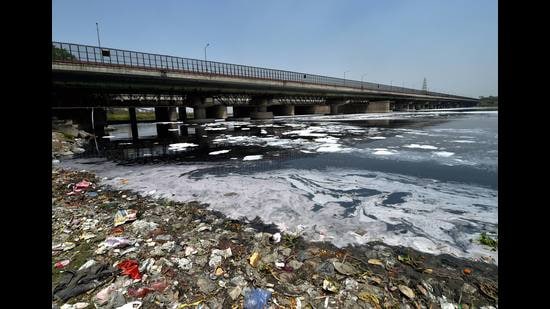Untreated effluent from Haryana contaminating Yamuna waters: Report
Millions of litres of untreated effluent are being discharged into river Yamuna from Karnal’s Indri block contaminating the river which is considered a major source of drinking water in the national capital, shows the fifth report of the River Yamuna Monitoring Committee
Millions of litres of untreated effluent are being discharged into river Yamuna from Karnal’s Indri block contaminating the river which is considered a major source of drinking water in the national capital, shows the fifth report of the River Yamuna Monitoring Committee.

As per reports collected from the stakeholders, around 66 MLD is coming from the industrial city of Yamunanagar and mixed in Yamuna water near Nabipur village after travelling to around 80km via Ganda Nallah, a ditch drain and Dhanaura escape canal from Yamunanagar to Indri block in Karnal district.
Even as the issue was highlighted in almost all monthly meetings of the River Rejuvenation Committee held under the chairmanship of chief secretary Vijai Vardhan, there was nothing visible on ground to check the flow of toxic water into the river.
The status report of the Implementation of River Action Plans submitted in the last monthly meeting on November 2, emphasised that sewage from unauthorised colonies is to be tapped or diverted at different locations by officials of the urban local bodies department to check pollution in Yamuna and Ghaggar rivers.
The urban local bodies department failed to submit the action plan to check the flow of effluent in both Yamuna and Ghaggar from various discharge points highlighted by the Haryana State Pollution Control Board (HSPCB), revealed the report.
The report highlighted a huge gap between the estimates of sewage generation and actual sewage reaching the sewage treatment plants (STPs). Sewage generation in the industrial cities of Yamunanagar and Jaghadhri is much higher than the quantum of sewage reaching up to the STPs as in Yamunanagar 29.3 MLD sewage was generated but the actual discharge reaching the STPs was 43.7 MLD and in Jagadhri the actual discharge reaching to the STPs was 18.5 MLD against sewage generation of 16.86 MLD.
Yamunanagar deputy commissioner Parth Gupta said the government has proposed to develop a 75 MLD STP to tap the untreated water flowing through the ditch drain, but which department (urban local bodies or public health engineering) will undertake the task, is yet to be decided.
In Ompal Chaudhary and others v/s State of Haryana at the National Green Tribunal (NGT), the petitioner had highlighted how the said discharge is contaminating the groundwater and the foul smell is affecting public health at large. Multiple media reports have also explained the effects of the chemical discharge (including heavy metals) on the cattle, agriculture fields and the inhabitants.
However, Nirmal Kashyap, regional officer of the HSPCB, said that the biological oxygen demand (BOD) in the subsequent months has decreased, suggesting that along with the untreated industrial waste, treated water from some STPs that started operations in the last two years, is also flowing into the ditch drain.
On the other hand, in Panipat the actual discharge reaching to the STPs was 42 MLD against 81.80 MLD sewage generated, reads the report mentioning that the waste water reaching the STPs for treatment is higher than the estimated generation of sewerage in many towns.
Moreover, of total 59 STPs in the Yamuna catchment area, only six have been upgraded and the rest do not meet the prescribed standards. Only 21 STPs are complying even though the deadlines for most STPs have already expired.
Also, sludge management has not been scientific so far and the regional officers of the HSPCB did not give proper reports to establish that sludge is disposed properly.
On the untreated effluent being discharged in river Yamuna, HSPCB member secretary S Narayanan said, “We are taking samples on daily basis and have found the ammonia levels well within the prescribed limits. It is not exceeding the limits.”
On tapping of pollution sources in Yamuna, he said, “Tapping of effluent in the river was going on large scale and any illegal discharge has been put on hold and special teams have been formed with the help of the district administrations concerned.”
“If the CPCB issues any further directions, we are ready to follow them,” he added.
The member secretary admitted that the untreated effluent from Dhanaura escape canal is being released into Yamuna. “But the departments concerned, including ULBDs and public health engineering department are working on it. There is need to set up a new STP in Yamunanagar, which is still pending for approval. The chief secretary has asked them to expedite the process.”
Officials in HSPCB slammed the statements made by the officials and leaders of political parties of Delhi that Haryana was polluting Yamuna water saying that water reaching Faridabad from Delhi is more polluted than it reaching Delhi from Haryana, but they do not want to indulge in blame game.



